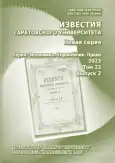Development of Russian precious metals sales planning under the conditions of macroeconomic and geopolitical instability
- Autores: Stepanov I.A.1
-
Afiliações:
- National Research Nuclear University MEPhI (Moscow Engineering Physics Institute)
- Edição: Volume 23, Nº 2 (2023)
- Páginas: 174-179
- Seção: Articles
- URL: https://journals.rcsi.science/1994-2540/article/view/252068
- DOI: https://doi.org/10.18500/1994-2540-2023-23-2-174-179
- EDN: https://elibrary.ru/MDSXFS
- ID: 252068
Citar
Texto integral
Resumo
Palavras-chave
Sobre autores
Ilya Stepanov
National Research Nuclear University MEPhI (Moscow Engineering Physics Institute)31 Kashirskoe shosse, Moscow 115409, Russia
Bibliografia
- LBMA Precious Metal Prices. URL: https://www.lbma.org.uk/prices-and-data/precious-metal-prices#/ (дата обращения: 30.12.2023).
- Smales L. A. News sentiment in the gold futures market // Journal of Banking & Finance. 2014. Vol. 49. P. 275–286. https://doi.org/10.1016/j.jbankfin.2014.09.006
- Smales L. A. Asymmetric volatility response to news sentiment in gold futures // Journal of International Financial Markets, Institutions and Money. 2015. Vol. 34. P. 161–172. https://doi.org/10.1016/j.intfin.2014.11.001
- Zheng Y. The linkage between aggregate investor sentiment and metal futures returns: A nonlinear approach // The Quarterly Review of Economics and Finance. 2015. Vol. 58. P. 128–142. https://doi.org/10.1016/j.qref.2015.02.008
- Stiglitz J. E. Symposium on bubbles // Journal of Economic Perspectives. 1990. Vol. 4, iss. 2. P. 13–18. https://doi.org/10.1257/jep.4.2.13
- Shen J., Najand M., Dong F., He W. News and social media emotions in the commodity market // Review of Behavioral Finance. 2017. Vol. 9, iss. 2. P. 148–168. https://doi.org/10.1108/RBF-09-2016-0060
- Khalifa A. A., Miao H., Ramchander S. Return distributions and volatility forecasting in metal futures markets: Evidence from gold, silver, and copper // Journal of Futures Markets. 2011. Vol. 31, iss. 1. P. 55–80. https://doi.org/10.1002/fut.20459
- Zhao Y., Chang H.-L., Su Ch.-W., Nian R. Gold bubbles: When are they most likely to occur? // Japan and the World Economy. 2015. Vol. 34. P. 17–23. https://doi.org/10.1016/j.japwor.2015.03.001
- Khan K., Köseoğlu S. D. Is palladium price in bubble? // Resources Policy. 2020. Vol. 68. Art. 101780. https://doi.org/10.1016/j.resourpol.2020.101780
- Maghyereh A., Abdoh H. Can news-based economic sentiment predict bubbles in precious metal markets? // Financial Innovation. 2022. Vol. 8, iss. 1. P. 1–29. https://doi.org/10.1186/s40854-022-00341-w
- Gold Return Attribution Model (GRAM). URL: https://www.gold.org/goldhub/tools/gold-return-attributionmodel (дата обращения: 30.12.2023).
Arquivos suplementares









